Painted Smooth Ceilings – Falling in Love with Your Home
Welcome back. Many of you may participate or read a weekly WIWW (What I Wear Wednesday). Those women in blogland, they really know how to put an outfit together. I am seriously jealous because sometimes I feel wardrobe challenged. Maybe you can help me. Here is what I wore Wednesday:
This Pretty Handy Girl can’t wear her good duds on a painting day (although I’ve been known to do that occasionally.)
Painting is a nice segue into the first secret for “Falling in Love with Your Home”. Our home started out dark and dreary on the inside. Most of the rooms had dark wall colors, but the biggest problem was the dingy white popcorn ceilings. Those suckers are light sponges! They absorb the natural light and keep it all to themselves.
Here is a good example of the light difference between a smooth ceiling and a textured ceiling:
Both pictures were taken minutes apart in adjoining rooms that have the same south facing windows. The rooms are identical in size. The room on the left (master bedroom) has popcorn ceilings and light blue walls. If you look closely, you can see how each pock has a shadow. The texture effectively stops the light from being reflected. Meanwhile the ceiling on the right is smooth but the walls are a dark blue (son’s room). Despite the darker walls, the ceiling appears lighter because the light is reflected due to the lack of texture.
As you can see, we are able to lighten our rooms about 10 – 15% by scraping and painting just the ceilings! (Imagine what painting the walls a lighter color will do!)
Two more benefits of a smooth ceiling:
- A smooth ceiling will visually raise the ceiling, while the textured ceiling draws your focus to the texture and makes the ceiling feel lower. You’ll have to trust me on this one.
- And, a smooth ceiling will not collect as much dust. I don’t have to tell you how important that is for allergy sufferers (ahhh- choo! I’m allergic to dust mites.)
In summary, why do you want a bright and smooth ceiling? Because, it will reflect more light and natural light is a mood booster. And during the seemingly never-ending winter months, we all need more sunlight to avoid mild depression or gloom. Translated: Better mood = Loving Your Room!
This is how we do it:
We have the popcorn (textured) ceilings scraped. Notice how I said, “Have” them scraped. I am handy – as you know – but there are certain tasks that I won’t do. I successfully scraped the ceiling in our pantry, but my neck was in pain for a week afterwards. I vowed never again. It is also a good idea to pay a professional if you live in an older home. Textured ceilings may contain asbestos. (Thank goodness ours didn’t.)
Now, even if you don’t have textured ceilings, you likely can still benefit from adding a fresh coat of paint. Ceilings are usually neglected for years. They are often painted with a builder’s grade white paint. The builder’s white is a dingy off white color compared to an Ultra Bright Flat White. It also doesn’t age as well and will tend to yellow or dull over the years. Here is an approximation of how a builder’s white might look next to an ultra bright white color:
AND, let’s say you really don’t want to mess with those texture ceilings, if you buy a thick nap roller and repaint the ceiling with an Ultra Bright White, you will still notice a big difference. (One word of caution when painting textured ceilings. Paint over one spot and move on. If you go back over that spot while it is still wet it can pull the texture down.)
Tutorial for painting ceilings like a pro
Materials:
- Valspar Flat Ultra Bright White Latex Paint
(this is the brightest white we have found. Valspar is sold only at Lowe’s) - Latex Primer
- Paint tray
- Paint roller
- Roller extension rod
- Edger
- ScotchBlue Painters tape
- Tarp
- Fine grit sanding block
- Car Wash sized sponge and bucket
- medium size flat artist’s brush
Begin by covering every bare inch of floor with plastic or thick canvas tarps. And cover any furniture left in the room (although you should try to remove everything from a room when you paint, it is just easier that way, trust me.)
Remove blades on a ceiling fan, simply unscrew the arms from the motor:
Then cover your light fixture with a plastic bag and painter’s tape.
Next, apply painter’s tape around the top of the walls of your room. If you are going to re-paint your walls after the ceilings, you can skip this step.
Start with the primer (a must for newly scraped ceilings, but not necessary for previously painted smooth ceilings).
1. Use your edger around the perimeter of your room. I like this handy-dandy edger that has a hole for the extension pole (especially helpful if you have high ceilings or neck issues.)
2. After the perimeter of the ceiling is done, edge around any light fixtures or vents.
3. Reach for your roller. I like to work in 5′ sections. Start by rolling out a letter “W”. Then roll back and forth, up and down and in random directions until you have that section of ceiling covered.
This will insure that you don’t have racing stripes on your ceiling.
4. Continue working next to the section you just finished. Try to work into the previous section while the paint is still wet. Otherwise, let that section dry before trying to roll into tacky half-dry paint.
5. Allow the primer to dry, then lightly sand your ceiling to remove any specks that got into the paint. Wipe the ceiling with a damp sponge.
Now repeat steps 1-5 using the ultra bright white paint.
Let your ceiling dry and then add a second coat of the ultra bright white (yes, definitely use two coats to leave your ceiling looking like it was painted by a pro! Don’t skimp.)
When you are done, remove the painter’s tape and pull out a small flat artists brush.
Pour some wall color paint into a small cup (I like to keep spare paint for each room in small jelly containers or jars. That way if one of my boys (adult and child alike) should happen to mar a wall, I can fix it in a jiffy.) Use the flat brush to create a smooth line at the top of your wall. Then finish by touching up any ceiling spots that were missed.
Take a look at the difference in our office! The top picture shows the room right after the ceiling was scraped. During the day!
Wow, brighten my world! View more pictures of this room HERE.
Okay, so I really like the ultra bright smooth white ceilings, but I did come across this gorgeous ceiling over at Not Just a Housewife, that would also make you swoon over your room if you were to try it. Check out Stacy’s tutorial HERE.
P.s. If you are renting, please don’t despair. I will have some tips that don’t involve painting your home.
I leave you with a glimpse of hope for those of you snowed in this week:
 |
| Daffodils Popping Through the Ground |
 |
| Daphne Buds Getting Ready to Sprout |
I just took those pictures yesterday, February 2nd! I live in Raleigh, NC, so thankfully spring is on its way. (Don’t hate me.)


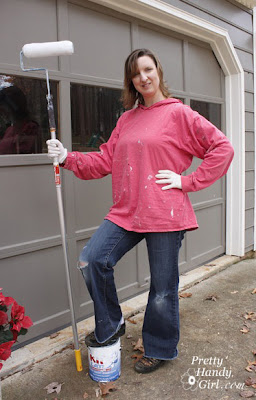
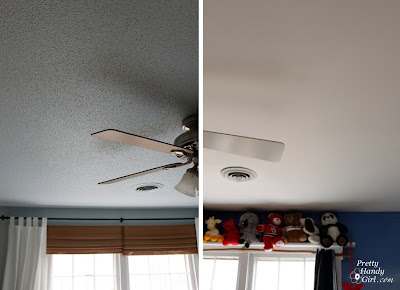

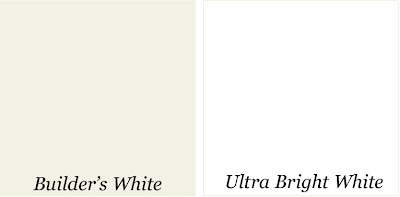
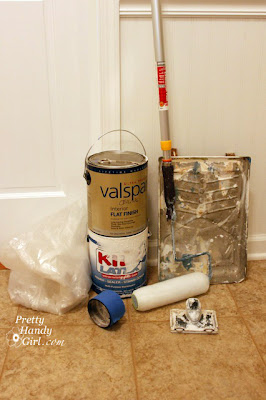

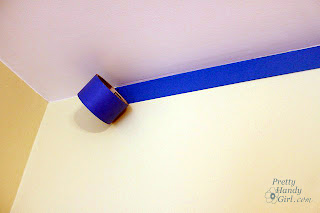

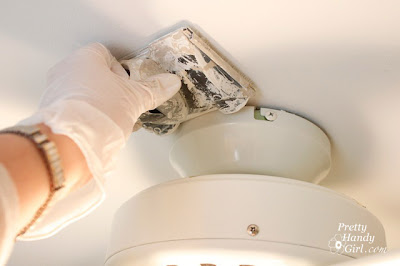
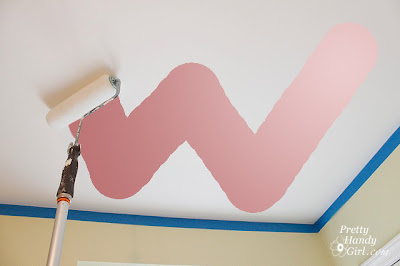

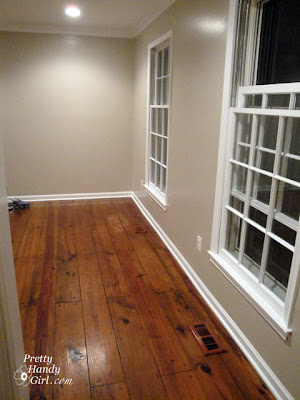


I just removed the popcorn and I like a flat surface but my husbund think is not going to look good only with primer and paint he wants to do texture which I don’t like. Please any advice? Thanks
Try to convince him to keep them smooth. They will feel taller, reflect more light and are much better for resale. Here’s some tips for prepping and painting ceilings: https://prettyhandygirl.com/painting-ceilings-like-a-pro/
Wow!! The house looks wonderful after that textured ceiling done. Now I have learnt how to paint on your own. Thanks for this blog!!
Thanks for all the great tips. I just bought my first house and I need to paint all my ceilings. Thankfully no popcorn to remove. I love the wall color you chose. Do you happen to remember the brand and color?
Suzanne, which photo are you looking at? The last room photo with the greige walls is Hot Spring Stones by Benjamin Moore.
Oh, please – no apologies! I sincerely appreciate your advice and opinion – that is why I asked! As I say, I’m an utter newbie, and I so respect and admire your depth of skill, knowledge and experience, and no less so your artistry – you are an amazing and inspirational woman! Thank you so much for your help – I will let you know how it goes – cheers!
Oh, please – no apologies! I sincerely appreciate your advice and opinion – that is why I asked! As I say, I am a complete novice and I respect and admire your depth of skill, knowledge and experience, and no less so your artistry – you are an amazing and inspirational woman – thank you so much for your help! I’ll let you know how the abatement and repair goes! Cheers!
Thank you so much for responding! I absolutely agree – since our ceiling definitely has asbestos, and as I was planning to hire a professional abatement company anyway, I thought while they were at it, rather than have them scrape, I’d just have them take the ceiling completely down. I worry about the possibility of asbestos still being present on the ceiling even after it’s been scraped – or possibly even scraped into the underlying sheetrock – and I’m not even 100% certain that whatever ‘wallboard’ was used to create the ceiling doesn’t contain asbestos itself! Our house was built in 1952 and I don’t know whether or not it was ever ‘remodeled’ (it does have horrible fake paneling in the same bedroom that has to go, too – lol!) Am I being paranoid?! I’ve read so much conflicting info about asbestos, I’m almost paralyzed about what to do, but I truly trust and value your opinion.! I’ve also read that covering up the old ceiling with new drywall is an option, but our ceilings are already only 8′ – and wouldn’t installing that disturb the *old* (i.e., asbestos-filled) popcorn underneath? Leaving it alone is not an option – a piece about 3″ in diameter (and almost a perfect circle – I think it was where a nailhead is coming through) just fell off without anyone disturbing it at all – I’m worried about what might be falling from it without our knowing, since the asbestos fibers are too small for us to detect. Thank you for any suggestions you may have!
I think your best option that will give you piece of mind and leave you with the best outcome is to have the abatement professionals remove it. Having been through the process myself, it took them one day to remove (flooring in our case.) And another day to get the air test results back.
If you choose not to remove the asbestos, but cover it up instead, by law you have to disclose that there is asbestos in your home when you go to sell it.
For your safety, I’d have it removed especially given the fact that it is already flaking off. Sorry, I wish I had a better alternative for you.
Howdy! I realize this post is old, so not sure you’ll be reading/responding to this question, but…curious as a cat, I am! Given the painstaking (emphasis on ‘pain’) work of scraping ceilings (not to mention which, in addition, ours definitely do contain asbestos – makes me a scared-y-cat, and concerned about possible lingering effects!), would it not make sense to have the ceiling completely removed and replaced with completely new sheetrock (that would contain no traces of asbestos)? Only looking at one small bedroom, approximately 10 x 12 and, while I realize the prepping of the space, etc., would need to be the same as if it were being scraped (sealed off, negative pressure, etc.), I would think the time factor of taking down the board vs. scraping off its applied texture, would be significantly less – no? And no issues with possible damaging of the ‘rock during scraping, although certainly it would need taping, mudding, etc. I value your opinion highly as I am an absolute novice and only know enough to get in over my head and then need to call in a professional! If you can respond that would be fantastic and if not, no worries – I know you’re incredibly busy. I love and read your blog every day (often RE-reading posts multiple times!) and especially appreciate your post today about the ‘walls’ holding us back. So true and applicable to so many situations in life. Bravo and THANK you! Cheers!
I’d much rather scrape ceilings than try to lift and hold heavy drywall sheets on the ceiling. In fact, I’d either hire a bunch of strong people to help hold it or one of those cool drywall jacks to accomplish that. Also, you’ll have a lot more deconstruction debris if you remove the drywall. Then factor in the time to tape and mud all your joints and corners. With scraping, that is already done for you. If you have asbestos popcorn, you should hire an asbestos abatement company (see more in my post about asbestos.: https://prettyhandygirl.com/asbestos-removal-everything-you-wanted-to-know-and-more/) Scraping isn’t that hard, it can just be a pain in the neck after a while (literally.) Here’s my post about scraping ceilings: https://prettyhandygirl.com/scraping-your-own-popcorn-ceilings-its-a-messy-job-but-someones-gotta-do-it/
After you scraped, how did you prepare the surface to paint on the smooth paint? I’ve been told that it’s near impossible to do a flat/smooth look due to the joints and putty on the drywall already. Thanks!
Kevin, it’s not impossible at all. Here’s my tutorial for scraping and smoothing ceilings: https://prettyhandygirl.com/scraping-your-own-popcorn-ceilings-its-a-messy-job-but-someones-gotta-do-it/
Why am I having so much trouble painting the W on my ceiling. I end up going in every kind of direction and getting dizzy. Is there an easy way to do this? It seems like it would be easy-as-pie, but maybe I’m W challenged!
Don’t stress it, the main thing is to just roll in random directions in a 4′ area so you don’t end up with racing stripes ;-). Make it an X or whatever random direction works for you. Good luck. And pop some Advil, your neck will hurt regardless.
Thanks for the tutorial! I just finished scraping and priming my living room ceiling! 🙂 Have two questions for you…#1 – did you attempt to correct any imperfections (nail holes, joint line issues) after the first coat of primer. I have a few imperfections that I missed and wondering if I can go back and correct before I paint? #2 – what grit sandpaper did you use to sand the primer coat? Thanks!
Staci, yes, you can still fix the imperfections. If it is only a small spot of spackle you can paint right over, but if it is larger, you should put some primer on after the spackle dries or the paint might not stick.
I just lightly sanded with a high grit 220 sanding paper to knock down any bumps or (gasp) dog hairs that might have stuck to the ceiling.
Best of luck! You are gonna love it!!!
Your home is so beautiful!!
Did you have to refloat and/or sand any of the drywall after removing the texture? I also want flat ceilings but Im worried about lines or imperfections showing through. I’ve finished scraping the popcorn off and I’m ready to start painting but I dont want to miss any necessary steps. Thanks!